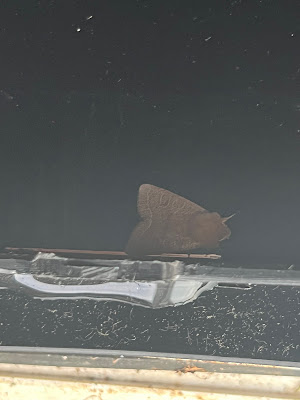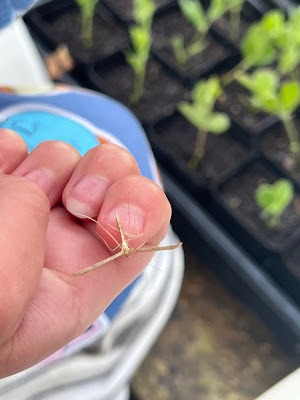As I mentioned at Christmas, my entomological granddaughter was brought her very own mothtrap by Santa Claus. Since then, she has waited with saintly patience for the rain and freezing weather to turn nicer. At last this week it did.
 Her first visitors were this very handsome Double-striped Pug, above, still with the russety colouring visible which gives it the scientific name of Gymnoscalis rufifasciata in which 'rufi' is the Latin for 'red.' More predictably, a Common Quaker woke up when she disturbed the eggboxes and crawled inquisitively on to her pyjamas after inspecting her fingertip.
Her first visitors were this very handsome Double-striped Pug, above, still with the russety colouring visible which gives it the scientific name of Gymnoscalis rufifasciata in which 'rufi' is the Latin for 'red.' More predictably, a Common Quaker woke up when she disturbed the eggboxes and crawled inquisitively on to her pyjamas after inspecting her fingertip. A second Common Quaker provided a useful lesson in making sure to search the whole trap, as it was hiding sleepily - first picture below -under a rim which overlaps the bowl. My granddaughter was notably delicate compared to her clumsy Grandpa, however, at persuading even a fragile and usually very jittery Common Plume on to her finger. Having moths on her fingers has been an enthusiasm for most of her ten years, the record being five hawk moths on one hand.
The star of the show, though, was a Nut-tree Tussock, a very attractive, medium-sized moth which has yet to pay a call to my own trap this year. It had no hesitation about obliging its captor with a wander round her hand and arm.
After she had gone to school, her younger brother and I discovered a second Double-striped Pug up on the ceiling, almost certainly an un-noticed escapee from the trap. Their parents, Penny and I had brought this in at about 10.30pm the night before when it began to rain and the species is so small that I think it could have found a way under the towel which we draped over the bowl for the night.
An interesting aspect of this debut was my granddaughter's sincere concern for her small, temporary prisoners. Whereas my generation when young had few if any second thoughts about pinning butterflies and moths to form collections of dead insects, her priority is to ensure that they all escape safely back in to the wild after photographs have been taken. It will be interesting to see how she copes with blackbirds and robins once they start to take an interest in what she is doing.
I also pondered, as I sat beneath two lovely cherry trees at school collection time later in the day, how this attitude - pretty general among the young and encouraged by teaching and modern environmental concern, will affect scientific study. Will we miss things through the absence of close examination of dead creatures, or will we form new insights by a more sympathetic approach to their ways?











No comments:
Post a Comment